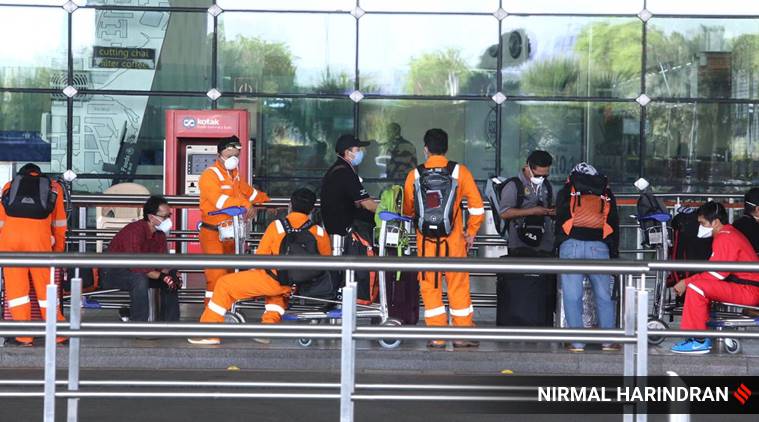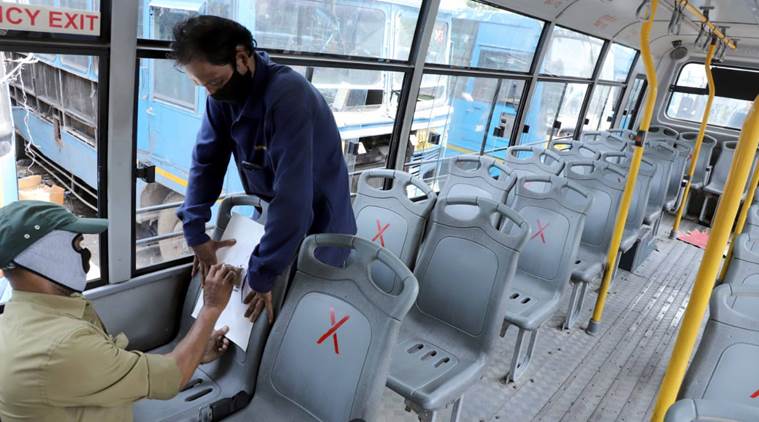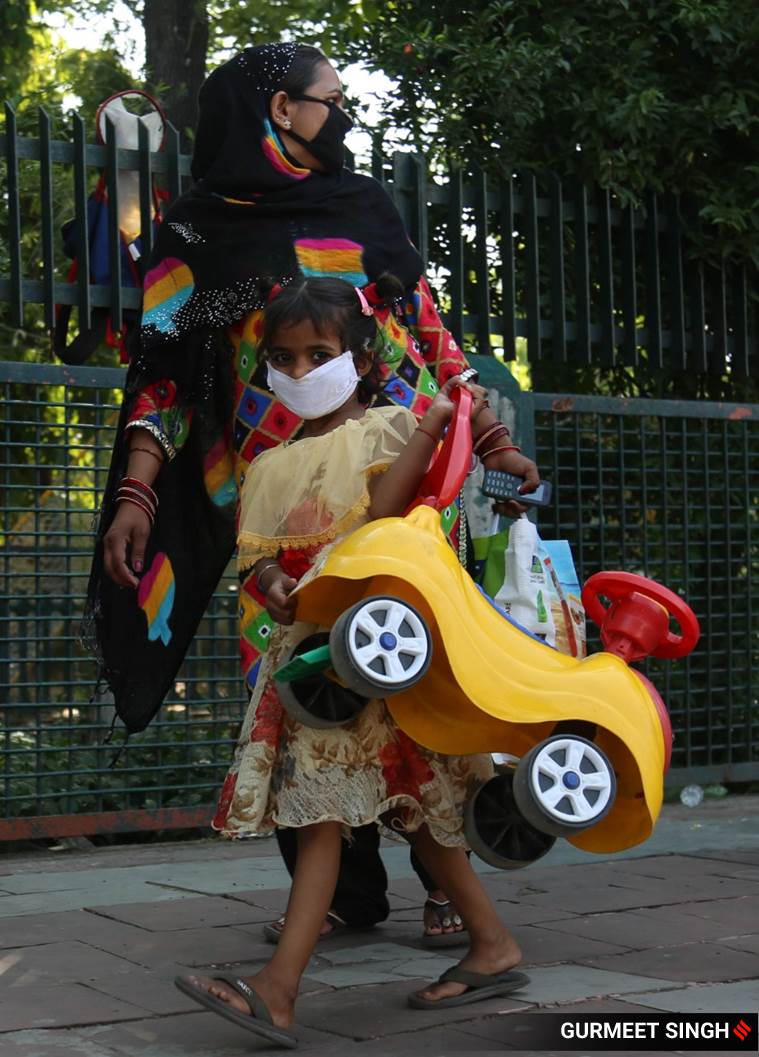 Passengers outside Mumbai airport
Passengers outside Mumbai airport
Coronavirus India update: The total number of infections in India rose to 1,38,845 on Monday. Of these 77,103 are active, while 57,720 patients have been discharged. The death toll stands at 4021. Data from Johns Hopkins University show that the total number of cases in India has surpassed that of Iran (with 1,35,701 confirmed infections). India now has the 10th highest number of confirmed cases worldwide. Globally, over 5.4 million people have been infected with the novel coronavirus, including 3.4 lakh deaths.
Meanwhile, after a hiatus of two months due to the coronavirus-induced lockdown, India opened up its domestic flight operations Monday. Hundreds of people reached airports across the country to take morning flights. At the airport, thermal screening, social distancing measures were put in place. The Delhi airport saw its first departure at 4.45 am to Pune while Mumbai airport’s first departure was at 6.45 am to Patna, the officials said.
Most of the state governments decided to put the passengers arriving from other states in institutional quarantine of seven to 14 days. Others made home quarantine for a fortnight mandatory for the travellers. Despite being vocal against resumption of domestic flights, Maharashtra — which is the worst hit by Covid-19 — allowed Mumbai airport to handle 50 domestic flights per day.
 Pune Mahanagar Parivahan Mahamandal Limited (PMPML) Swargate set to start its services in Pimpri-Chinchwad and suburban areas outside Pune city limits with 50 per cent capacity (Express Photo: Pavan Khengre)
Pune Mahanagar Parivahan Mahamandal Limited (PMPML) Swargate set to start its services in Pimpri-Chinchwad and suburban areas outside Pune city limits with 50 per cent capacity (Express Photo: Pavan Khengre) A woman and her daughter at Guru Nanak Dev Stadium in Ludhiana for screening before boarding train from railway station.
A woman and her daughter at Guru Nanak Dev Stadium in Ludhiana for screening before boarding train from railway station.
In today's episode of Three Things podcast, our reporter Pranav Mukul clears the confusion regarding domestic flights, the clashes between the states and the Centre, and the reason why flights have been made to resume. Next, Karishma Mehrotra discusses the lack of testing facilities in districts recording new cases and explains why this problem is of particular significance now. Listen to them, here
UP Chief Minister Yogi Adityanath on Sunday said states seeking to employ migrant workers from Uttar Pradesh in the future will need to take his government’s permission. Adityanath, addressing a webinar, said, “Now, if any state needs manpower, the UP government will give the manpower social security. We will give them insurance and security. But, without our permission, our people cannot be taken by other states. Because the kind of treatment that was meted out [to UP residents]. Seeing that, we have taken the people’s social security in our hand.”
The head of a trades union association in Tehran said all businesses, including those deemed “high risk,” should reopen on Tuesday, the state-run Islamic Republic News Agency reported. Mosques and shrines are due to reopen on Monday, after the Muslim holiday of Eid.
From an Indian food company placing one of its top-selling products against the tri-colour background to a foreign shoemaker invoking its 89-year old presence in the country to buttress its Indian roots, companies are bracing to either leverage Prime Minister Narendra Modi’s “vocal for local” call as a tool to market their brands under the nationalistic banner or are gearing up to tackle potential backlash on account of a brand’s foreign identity — depending on which side of the divide they’re on.
According to senior people in several companies The Indian Express spoke with soon after the Prime Minister said that every Indian “has to become vocal for their local, not only to buy local products, but also to promote them proudly”, C-level executives scrambled to come up with a plan to get the brand’s messaging across.
By the time the week ends, everyone will be watching out again for what the government decides on the lockdown. The lessons from the limited reopening of air travel, rail travel, and inter-state movement will guide the next course of decision. There is another, non-Covid development that is likely to linger this week – the Chinese transgressions along the LAC in Ladakh, writes Ravish Tiwari in this week's ExplainSpeaking column
India on Monday reported 1,38,845 cases. Of these 77,103 are active, while 57,720 patients have been discharged. The death toll stands at 4021. Data from Johns Hopkins University show that the total number of cases in India has surpassed that of Iran (with 1,35,701 confirmed infections). India now has the 10th highest number of confirmed cases worldwide. Globally, over 5.5 million people have been infected with the novel coronavirus, including 3.4 lakh deaths.
The biggest news on the state of the Indian economy will come towards the end of this workweek — on May 29, to be precise — when the Ministry of Statistics and Programme Implementation (MoSPI) releases the “Provisional Estimates” (PE) for the last financial year — that is, 2019-20. The provisional GDP data carries crucial clues for the FM and her team to understand which sectors were struggling the most anyway (say manufacturing or trade) and which could lead us to recovery (say agriculture) and the policy mix needed for turning around the economy.
The provisional estimates on Friday will provide the essential basis for forecasters to start projecting GDP for the current year. There is only one difference though: unlike normal year, when this data would have resembled the floor for the next year’s growth, this time, it is likely to be the roof, writes Udit Misra in this week's ExplainSpeaking column
Experts on a special government panel have approved a plan to remove a coronavirus state of emergency from Tokyo and four other remaining prefectures, paving the way for Prime Minister Shinzo Abe to declare entirely ending the measure to allow businesses to gradually resume. Economy Minister Yasutoshi Nishimura told reporters that experts on a government-commissioned panel approved the plan to end the state of emergency that has lasted for more than a month and a half. Abe is to officially declare the end of the state of emergency later Monday after endorsement from parliamentary committees. Nishimura said lifting of the emergency does not mean the end of the pandemic. He said the goal is to minimize next possible recurrences of infections while balancing preventive measures and the economy. (AP)
The first flight has landed in Srinagar. "Eight flight will operate today and numbers will increase in the coming days," says Director Srinagar Airport, Santosh Dhoke. In Jammu and Kashmir, all incoming passengers will have to undergo "administrative quarantine" for a fortnight. Thirty kiosks have been set up at Srinagar airport for the collection of samples. (Input from Adil Akhzer)
While the government has maintained that the low positivity rate (share of tests that yield positive cases) does not warrant more intensive testing for Covid, ICMR records show a steady rise in positivity rates over the last four weeks. More so in the last 10 days when migrant workers have started returning home on board Shramik Special trains.
ICMR records show that between April 16 and 28, the positivity rate slumped from 4.8 per cent to 3.0. But this began inching up since then to 7.0 at the end of day on May 23. Replying to a question from The Indian Express, ICMR DG Balram Bhargava admitted that rising positivity is a cause for concern.
Air travel resumed across India this morning, two months after the lockdown announced by Prime Minister Narendra Modi. Hundreds of people across the nation reached airports to take flights. The first domestic flight took off from New Delhi for Pune at 4:45 am.
In Delhi, domestic flights will operate out of T3 and passengers will be advised to arrive two hours before departure. At the entry road, hoardings and placards with flight details will be displayed, and there will be several entry gates to prevent crowding. All passengers will be required to have the Aarogya Setu app installed, where officials will check the person’s status, along with his or her temperature on a thermal screening device.
Senior Congress leader and Public Works Department Minister Ashok Chavan has tested positive for Covid-19. He is the second minister in the Uddhav Thackeray government to catch the infection after Housing Minister Jitendra Awhad. Chavan is currently admitted at a hospital in Nanded. His condition is stable, sources said, adding that he was reportedly under home quarantine for the last few days.
In the nearly three months the Coronavirus has been in India, the one enduring trend has been the dominance of Maharashtra in the growth of Covid in the country. If anything, this has steadily strengthened with time. As India’s caseload has gone past 1.3 lakh, Maharashtra’s share has increased to more than one-third. In the last ten days, more than 40 per cent of new infections detected in the country have come from Maharashtra.
Such is the dominance that whenever Maharashtra has managed to slow down its growth for a while, it has slowed the national growth rate as well. And, the opposite has been true as well. In fact, the curve for the national growth rate very closely resembles that of Maharashtra (see chart). Same is true when it comes to doubling time of cases.
Days after the state government declared Pimpri-Chinchwad a non-red zone, the industrial city continues to see a spike in Covid-19 cases with Anandnagar slums emerging as a hotspot. The rapid spread of infection in the slum has raised concern among PCMC officials, who are busy devising new strategies to bring the situation under control.
On Saturday, Anandnagar slums reported 26 positive cases. And on Sunday, 37 more tested positive, taking the tally of cases to 107. The figure is the highest for any suburb or slum of Pimpri-Chinchwad. Read more here